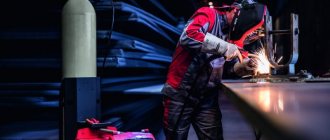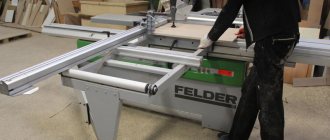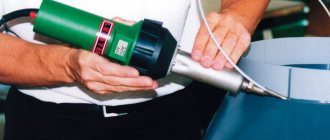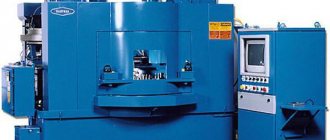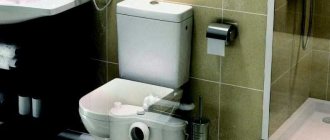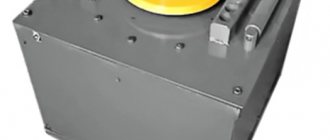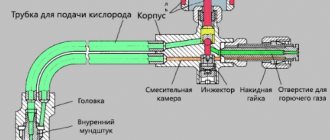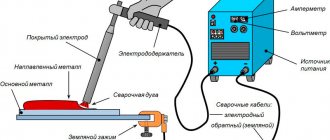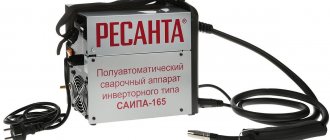Welding is one of the most significant inventions of mankind. After all, with its advent, people have the opportunity to create previously inaccessible products using monolithic metal compounds. Welding helped make a serious breakthrough in the manufacturing sector, the results of which humanity has continued to benefit from for decades.
At first, only electric welding , but as it improved, a more universal one, gas welding , appeared, which differed from electric welding in its wider scope of application. A special feature of gas welding is that in order to join metals, their surfaces are exposed to high temperatures resulting from the combustion of flammable gases in oxygen.
To carry out welding, it is necessary to create a special working environment, for which a special energy carrier is used - bottled gas or an acetylene generator . The welding itself is carried out using a torch or cutter . The final choice depends on the type of operations being performed. The main advantage of gas welding is the ability to join non-ferrous metals to create a neat and beautiful seam.
For welding, a single gas or a special mixture can be used, including butane, propane, argon, oxygen and other types of gases. But most often, welding is carried out using a mixture of acetylene with oxygen and oxygen with propane and butane, since today these are the most accessible types of gases, and the melt zone created with their help has the highest characteristics.
Equipment for gas welding work
To be able to carry out gas welding, you must ensure that you have the following units:
- An acetylene generator or a cylinder with another flammable gas. In domestic conditions, mobile acetylene generators are most often used, in which gas is produced as a result of the reaction of water with calcium carbide. But sometimes it is replaced with ready-made gas, which is most often used propane or butane. For greater convenience, it is desirable that the cylinders be equipped with flow meters.
- Oxygen cylinder.
- Safety valves for cylinders. They are safety devices that help prevent fire when the flame returns from the burner.
- Reducer for oxygen and working gas cylinders. They help regulate pressure.
- Supply hoses , also called hoses. Each group of gases has its own type of hose. There are three categories in total. In accordance with safety requirements, the hose must not be connected to a gas cylinder for which it is not intended.
- Burner . Today, gas burners almost always come with attachments that can be used to change the required flame parameters.
- Welding table . It represents the working area in which the welding process takes place. For safety reasons, the welding table must be equipped with a metal or brick plate.
Generally speaking, the entire set of equipment for gas welding is usually called a welding station . To avoid many difficulties, a special flat wheeled trolley with a frame is used to transport welding equipment, where the gas welding and cutting apparatus and cylinders are mounted in a vertical position using clamps, and the hoses are also arranged in a twisted form.
Such a post is highly mobile and can be delivered to the work site with minimal time. Such a need may arise when you need to weld on a fixed structure that cannot be brought closer to a gas welding machine.
Application area
- soldering;
- cutting;
- welding;
- planing;
- heat;
- descaling;
- heat treatment;
- automated heating solutions;
Properly selected autogenous equipment allows you to effectively solve many production problems in various industries and in the domestic sphere. Correct operation and routine maintenance in accordance with safety standards and manufacturer's recommendations will allow you to enjoy the work and get a quality result. The use of original spare and consumable parts will ensure reliability and long service life of the equipment. We guarantee an individual approach and attention to each Customer; for us, it is important both for an individual entrepreneur who wants to buy autogenous equipment and needs a good quality cutter or burner for crafts or a workshop, and for a large enterprise with its own special tasks and wishes. We have something to offer every potential Customer.
Additional tools and materials
But the above equipment alone is not enough to carry out gas welding work. In addition to the gas welding machine, it is necessary to prepare additional tools:
- Retainers . Necessary to facilitate gas welding work and improve the quality of the joint created. If the part is securely fixed in a static position, then working with it is much easier.
- Lift . When it becomes necessary to connect bulky parts that are difficult to transfer to the table manually.
- Installation tool. Includes a set of wrenches or wrenches used to securely secure key elements of the welding station.
- Related tool . This list should include hacksaws, sledgehammers, pliers, hammers and other devices.
- Hood . Welding, which involves joining metals using gas, necessarily requires effective ventilation.
One of the principles of gas welding technology is the use of filler wire, which fills the weld pool. The wire for welding must be selected taking into account the composition of the surfaces that need to be welded. It must have a uniform and smooth structure. In addition, fluxes are used when welding with gas. We are talking about special compositions, produced in the form of a paste or powder, which are applied to the additive and edges to protect the melt from oxides.
Benefits of oxyfuel cutting
The technology of oxygen and oxygen-flux cutting has many advantages. Among them:
- large thicknesses of cut metal (up to 500 mm), limited only by the design features of oxygen-flux cutting installations;
- low cost;
- high quality (modern machines make it possible to achieve an acceptable cutting width, no cutting taper, clean edges that do not require processing);
- possibility of using multi-cutter schemes.
High-quality oxygen cutting is carried out by MetiStr specialists, who have high-precision machines and extensive experience in their arsenal.
All articles >
Popular models
Today there is a wide selection of welding equipment on sale. There are many manufacturers on the market whose range includes equipment designed for portable and stationary welding. Quite a lot of offers can be found from Chinese manufacturers, however, it is best to opt for products from Russian or European companies:
- Ideal (Germany).
- Steiger (Germany).
- Graphopress (Netherlands).
- kz (Russia).
- Dioxide (Russia).
Criterias of choice
- The basic principle on which it is recommended to select gas welding equipment is the type of work planned. Depending on whether cutting or joining is planned, the choice of the most affordable gas is made. In most cases, acetylene is used for gas welding.
- And also when choosing gas welding equipment, it is necessary to take into account the thickness of the metal. Acetylene is recommended to be used when it is necessary to weld parts made of low-carbon and alloy steels with a thickness of no more than 20 mm. To cut thick-walled metal up to 400 mm, you need propane, which is used with a standard pressure mode. If the products being welded have a thickness of about 400-800 mm, then in this case increased oxygen purging will be required, and this can lead to an increase in pressure in the gas pipeline.
- Another important selection criterion is the technical capabilities of the gas burner or cutter used.
Operating principle of the installation
Structurally, equipment for plasma separation cutting of metals includes the following components:
- Power source - serves to supply current and voltage to excite the pilot and cutting arc. It can have a steeply falling current-voltage or constant current characteristic.
- Plasma torch is a device for generating and stabilizing a plasma jet. It has a complex structure, the main elements of which are a nozzle, a cathode, and a swirler.
- Cooling system - designed to cool cables and plasma torch, which are subject to excessive heating. Installations with a power of 100 A or more are equipped with water cooling, less powerful devices with air cooling.
- A reproduction system or CNC (numerical control) is a complex that ensures automatic movement of a support with a plasma torch along a contour specified by a special program.
- Cutting table (relevant for automatic CNC machines) - is a steel flooring for placing rolled metal that will be cut.
Figure 1. Approximate diagram of equipment for automatic plasma cutting
The principle of operation is the formation of plasma, which the plasmatron forms into a directed jet. A direct plasma arc occurs when current flows from the cathode (non-consumable electrode) to the anode (steel billet). Due to the high energy density and high temperature (up to 5000-30000 °C), the plasma expands, which leads to its high-speed (up to 3 km/sec.) outflow towards the rolled metal.
A plasma jet is formed by a small hole in the nozzle and, thanks to the directed effect, instantly heats the metal to the melting point, blowing it out of the cutting zone.
Figure 2. How the devices work
The sequence of working with the settings is as follows:
- Preparation - laying a metal sheet on a work table, to which a “positive” wire connected to a power source is connected. The “negative” wire is connected to the electrode in the plasmatron. Checking the functionality of equipment, integrity of hose packages, etc.
- Ignition of the pilot arc by supplying high voltage and initiation of the cutting arc when the pilot arc touches the material being cut.
- Burning of metal and movement of the plasma torch along a given contour with a constant speed and distance between the workpiece and the nozzle.
Photo 3. Plasma jet separation cutting process
Equipment Specifications
Gas cylinders
Welding, which is carried out using portable equipment, involves the use of gases stored in special hermetically sealed vessels - cylinders. Each gas must be stored in a container suitable for it, which must have a special shape, dimensions and valve.
- Oxygen cylinders. For their production, alloy or carbon steels are used. Sometimes oxygen cylinders are made from seamless pipes, but they can only store gas for which the permissible pressure is no more than 30 kgf/cm². If it is necessary to maintain a lower pressure in the cylinder, then it should be made only of welded structures. In the latter case, it is recommended to use types 150 and 150JL with a maximum volume of 40 l. Moreover, it is important that during the manufacture of structures the requirements of GOST 949–73 are met.
- Acetylene cylinders. During their production, the requirements of GOST 5948–60 must be met. Most often, in order to ensure maximum safety, such containers are made in the form of two-chamber cylinders, which make it possible to more effectively equalize the pressure inside them. But at the same time, it is important to comply with the main condition - the internal pressure in the acetylene cylinder should not exceed 19 kgf/cm² at 20ºC.
- Cylinders for propane-butane mixture. Their production must be carried out in accordance with the requirements of GOST 15860–70. Such cylinders are made in volumes of 40 and 50 liters. The internal pressure in them should not exceed 16 kgf/m², and they should weigh no more than 24 kg.
Particular care must be taken when handling gas cylinders, as they belong to a high explosion hazard category. As a result, during their use, particularly stringent requirements for their operation must be observed. To be able to transport or carry them, a specialist must undergo special training and obtain a permit.
Cutters
In order to be able to change the pressure of flammable gas on welding equipment, each cylinder must be equipped with a reducer. When choosing a gearbox, first of all you need to pay attention to its throughput. It should be selected based on the type of work being done and the cutters used. Gearboxes come in two types, depending on the design: single-stage and two-stage. The latter are more accurate.
When the gases from the cylinder reach the cutter, they mix. The main part of the cutter is most often made of carbon steel and is equipped with various functional elements - shut-off valves, injectors, a mouthpiece, which are repairable. The cutter itself is necessary to control the welding process and mixing gases.
Cutters may differ from each other in power, which implies their throughput. Based on this, we can conclude that for each cutter it is necessary to select the appropriate burner, which must be of a certain type and size. All cutters have removable parts, so they are universal and can be used for welding with any type of gas.
Cost of metal cutting machines
The price of equipment for separation plasma cutting of metal depends on operating parameters and functionality:
- type – manual or automatic with CNC;
- maximum operating current;
- PV (on duration) – household (up to 60%), semi-professional (60 to 80%), professional (80-100%).
The category of budget devices includes inverter devices for manual cutting with a maximum duty cycle of 60%. Models designed for more intensive use belong to the middle price category. CNC machines are the most expensive; they are usually equipped with large industrial enterprises where mass production of products is established. Therefore, it is important to initially determine the principles for the selection and future operation of machines.
